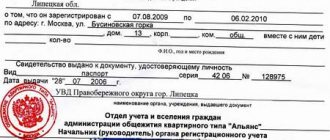1. A representative office is a separate division of a legal entity, located outside its location, which represents the interests of the legal entity and protects them.
2. A branch is a separate division of a legal entity located outside its location and performing all or part of its functions, including the functions of a representative office. 3. Representative offices and branches are not legal entities. They are endowed with property by the legal entity that created them and act on the basis of the provisions approved by it.
The heads of representative offices and branches are appointed by the legal entity and act on the basis of its power of attorney.
Representative offices and branches must be indicated in the unified state register of legal entities.
Definition of terms
First of all, let us make a reservation that the terminology of civil and tax law differs. In the Tax Code of the Russian Federation (hereinafter referred to as the Tax Code of the Russian Federation, the Code) there is no definition of the concept of a branch, as well as the concept of a representative office. At the same time, Article 11 of the Tax Code of the Russian Federation indicates that the institutions, concepts and terms of civil and other branches of legislation of the Russian Federation used in the Code are applied in the meaning in which they are used in these branches of legislation, unless otherwise provided by the Code. Therefore, we will use these terms for tax purposes exactly in the meaning in which they are used in civil legislation.
The concepts of “branch” and “representative office” are given in Article 55 of the Civil Code of the Russian Federation (hereinafter referred to as the Civil Code of the Russian Federation). According to the provisions of this norm, a representative office is a separate division of a legal entity, located outside its location, which represents the interests of the legal entity and protects them.
A branch is a separate division of a legal entity, located outside its location, and performing all or part of its functions, including the functions of a representative office.
Based on the definitions, we can conclude that the main difference between a branch and a representative office from each other is their functional purpose: a representative office only represents the interests of a legal entity in its relations with participants in civil transactions, for example, it performs the functions of conducting negotiations and subsequent conclusion of transactions, as well as protecting the interests of the organization in the courts.
The branch also represents the interests of the legal entity, i.e. including performing the functions of representation. In addition, the branch carries out all or part of the functions of a legal entity. In other words, the branch not only negotiates and makes transactions on behalf of the legal entity, but also carries out actual actions aimed at fulfilling the concluded contracts, i.e. conducts production, trade or other activities, the implementation of which is carried out by the legal entity itself. At the same time, a branch can perform all types of activities of the organization, or some of them.
Article 55. Representative offices and branches of a legal entity
Appeal ruling of the Judicial Collegium for Administrative Cases of the Supreme Court of the Russian Federation dated April 24, 2019 N 32-APA19-1 Based on the provisions of Article 123.1 of the Civil Code of the Russian Federation, paragraph 1 of Article 2 of the Federal Law of January 12, 1996 N 7-FZ “On Non-Profit Organizations” ", Article 37 of Federal Law N 82-FZ, the entrepreneurial activity of a public organization must be additional and contribute to the creation of a material base for the effective implementation of statutory goals, and not be the main purpose of the activities of the Organization represented by its branches, which, by virtue of the provisions of Part 2 of Article of the Civil Code of the Russian Federation Federations are recognized as separate divisions of a legal entity located outside its location and performing all or part of its functions, including the functions of representation. Consequently, the activities of the branch in any case must correspond to the goals stated in the organization’s charter.
Determination of the Constitutional Court of the Russian Federation dated April 25, 2019 N 1051-O
Also S.I. Zakolodkin asks to declare the Constitution of the Russian Federation, its articles , (part 4), (part 3), (part 1), , , (part 3), (clauses “c” and “o”) and (part 1) not in compliance with Article 1288 of the Civil Code of the Russian Federation, since, according to the meaning given to it by law enforcement practice, it allows for the inclusion in an author’s contract of an implicit condition on the alienation of the exclusive right to a work and the determination of the content of this condition by the courts by interpreting the contract, taking into account the purposes of its conclusion and the possibilities of its execution.
Resolution of the Supreme Court of the Russian Federation dated December 3, 2019 N 5-AD19-242
Moreover, in accordance with paragraphs 2 and 3 of Article of the Civil Code of the Russian Federation, a branch is a separate division of a legal entity located outside its location and performing all or part of its functions, including the functions of a representative office. Branches must be listed in the unified state register of legal entities.
Resolution of the Supreme Court of the Russian Federation dated February 11, 2019 N 81-AD19-1
A branch is a separate division of a legal entity located outside its location and performing all or part of its functions, including the functions of a representative office (clause 2 of Article of the Civil Code of the Russian Federation). As established during the consideration of the case, the owner (proprietor) of the non-public railway access track crossing the highway on which the unregulated railway crossing is located, located at the above address, is a structural unit of the company - Belovskaya track distance.
Resolution of the Supreme Court of the Russian Federation dated February 25, 2019 N 67-AD19-1
A branch is a separate division of a legal entity located outside its location and performing all or part of its functions, including the functions of a representative office (clause 2 of Article of the Civil Code of the Russian Federation). Railway stations Mochishche, Bugotak, Inya-Vostochnaya, Kochenevo, Izynsky, Ob, Dorogino, Posevnaya, Bolotnaya, Lozhok, included in the West Siberian Traffic Control Directorate, which is a structural subdivision of the Central Traffic Control Directorate - a branch of the open joint-stock company Russian Railways, where violations of legal requirements for ensuring transport security were detected are not branches of the named legal entity.
Resolution of the Supreme Court of the Russian Federation dated June 17, 2019 N 5-AD19-36
Moreover, in accordance with paragraphs 2 and 3 of Article of the Civil Code of the Russian Federation, a branch is a separate division of a legal entity located outside its location and performing all or part of its functions, including the functions of a representative office. Branches must be listed in the unified state register of legal entities.
Ruling of the Supreme Court of the Russian Federation dated August 20, 2019 N 306-ES19-15902 in case N A12-20135/2018
In satisfying the claim, the courts were guided by Articles 307, 309, 310, 1102 of the Civil Code of the Russian Federation, Federal Law dated 06.10.2003 N 131-FZ “On the general principles of organizing local self-government in the Russian Federation” and, having examined and assessed the evidence presented in the case according to the rules of Article 71 of the Arbitration Procedural Code of the Russian Federation, proceeded from the unreasonable overestimation by the defendant of the tariff for the services provided to the plaintiff for the delivery of address-based payment documents to the population in the urban district of the city of Mikhailovka, Volgograd Region.
Determination of the Constitutional Court of the Russian Federation dated December 19, 2019 N 3398-O
1. Citizen A.N. Preminin disputes the constitutionality of paragraph 3 of Article of the Civil Code of the Russian Federation, according to which representative offices and branches are not legal entities; they are endowed with property by the legal entity that created them and act on the basis of the provisions approved by it; heads of representative offices and branches are appointed by a legal entity and act on the basis of its power of attorney; representative offices and branches must be indicated in the unified state register of legal entities.
Ruling of the Supreme Court of the Russian Federation dated March 10, 2017 N 309-ES17-180 in case N A34-5669/2015
Having examined and assessed the presented evidence according to the rules of Article 71 of the Arbitration Procedure Code of the Russian Federation, guided by Article , of the Civil Code of the Russian Federation, Articles 5, 32, 44, 50 of the Federal Law of 02/08/1998 N 14-FZ “On Limited Liability Companies” and the provisions of the Federal Law of 11.21.1996 N 129-FZ “On Accounting”, the court, based on the specific circumstances of the case, granted the claim in the contested part, coming to the conclusion that it was proven that Pogorelov S.N. as the head of the company "Avtogazsistema" in the period from 03/05/1998 to 03/05/2014, the duties of ensuring the safety of documentation related to the activities of the company, and non-fulfillment by S.N. Pogorelov. this obligation, as well as to the conclusion that the fact of transfer by Pogorelov to S.N. disputed documents to the newly appointed director of the company.
Decision of the Supreme Court of the Russian Federation dated March 21, 2017 in case No. AKPI17-164
By virtue of paragraph 3 of Article of the Civil Code of the Russian Federation, Article 5 of Federal Law of August 8, 2001 N 129-FZ “On State Registration of Legal Entities and Individual Entrepreneurs”, information about branches and representative offices of a legal entity must be indicated in the Unified State Register of Legal Entities .
Ruling of the Supreme Court of the Russian Federation dated December 7, 2017 N 304-KG17-17818 in case N A03-10250/2016
In addition, taking into account the provisions of budget legislation, articles of the Civil Code of the Russian Federation, Article 39 of the Charter of the municipal formation Kosikhinsky District of the Altai Territory Administration of the District, Order of the Treasury of Russia dated December 29, 2012 N 24n “On the Procedure for opening and maintaining personal accounts by territorial bodies of the Federal Treasury” , Federal Law dated 06.10.2013 N 131-FZ “On the general principles of organizing local self-government in the Russian Federation”, the courts indicated that the Treasury had no legal grounds for suspending transactions on the accounts of the committees and departments specified by the applicant due to their lack of status of a separate (structural) division of the administration.
General characteristics of a branch and representative office
Having considered both concepts, we can identify features that are similar for both the branch and the representative office. The first and, perhaps, most defining feature comes down to the fact that neither the branch nor the representative office are legal entities, i.e., independent participants in civil transactions, but enter into civil, labor, tax and other legal relations on behalf of the legal entity that created them . In practice, this feature is reflected in the following:
- transactions on behalf of a branch or representative office are concluded by the legal entity itself;
- it is also responsible for obligations arising in connection with their activities;
- branches and representative offices cannot act as plaintiffs and defendants in court, i.e. cannot independently participate in legal proceedings on their own behalf.
This is how the Presidium of the Supreme Arbitration Court of the Russian Federation (hereinafter referred to as the SAC RF) comments on this issue in Information Letter No. 34 dated May 14, 1998 “On the consideration of claims arising from the activities of separate divisions of legal entities”: “... a separate division that is not a legal entity , may bring a claim only on behalf of a legal entity... The statement of claim signed by the head of a separate division must be accompanied by a power of attorney (or a copy thereof) of the legal entity confirming his authority to sign the statement of claim on behalf of the legal entity.”
In the absence of such a power of attorney, the statement of claim is returned without consideration, on the basis of clause 2, part 1, art. 108 Arbitration Procedure Code of the Russian Federation.”
A similar conclusion is contained in the Resolution of the Plenum of the Supreme Court of the Russian Federation and the Plenum of the Supreme Arbitration Court of the Russian Federation dated June 11, 1999 N 41/9 “On some issues related to the implementation of part one of the Tax Code of the Russian Federation.” By virtue of clause 9 of this Resolution, branches and representative offices of Russian legal entities are not considered as participants in tax legal relations and do not have the status of taxpayers, tax agents and other obligated persons. Responsibility for failure to fulfill all obligations to pay taxes, fees, penalties and fines lies with the legal entity that includes the relevant branch (representative office).
Guided by this legal position, the FAS Moscow authority in its Resolution dated April 15, 2009 No. KA-A40/1708-09 noted that branches are not subjects of tax legal relations, therefore, cannot be brought to tax liability, since liability for actions (inaction) of branches only a legal entity can be involved.
The problem of territorial isolation
Territorial isolation, or location outside the location of the organization, is also an important defining feature of both a branch and a representative office. In accordance with paragraphs 2 and 3 of Art. 54 of the Civil Code of the Russian Federation, the location of a legal entity is determined by the place of its state registration and is indicated in its constituent documents.
In the 90s and 2000s, there were fierce disputes between lawyers about what was the “location” of a legal entity? Some believed that this was a specific address, i.e. settlement, street, house, office where the permanent executive body of a legal entity is located, or in its absence - another body or person authorized to act on behalf of the legal entity without a power of attorney, information about which is contained in the Unified State Register of Legal Entities (hereinafter referred to as the Unified State Register of Legal Entities). In accordance with this assumption, territorial isolation means that if an additional office of a company is located in the same locality, on the same street and even in the same house as the legal entity that created them, but in a different premises from it, they can safely be classified as branch or representative office.
Other lawyers believed that the location of a legal entity should not be considered a specific postal address contained in the Unified State Register of Legal Entities, but rather affiliation with a specific subject of the Russian Federation (for example, St. Petersburg, Moscow, Saratov, and so on).
This dispute was resolved only in 2015, when the legislator adopted Law No. 209-FZ of June 29, 2015. This regulatory act amended the Civil Code of the Russian Federation and established that the location of a legal entity is a specific locality (municipal entity) on the territory of the Russian Federation. In turn, the Unified State Register of Legal Entities indicates the address of the legal entity within its location.
Thus, territorial isolation, as a sign of a branch or representative office, means that a legal entity can create them only outside its location, i.e. outside the locality (municipal entity) where the parent company is registered.
Issues of property isolation
The property isolation of branches and representative offices, as their next important feature, means that, firstly, they have the right to own and use property allocated by a legal entity to a separate balance sheet, and secondly, they have the right to have a separate current account.
However, regarding the “separate balance sheet of a separate division”, not everything is so simple. The legislation does not know such a term at all. In practice, it is understood as a document with reporting information on the activities of an economic entity, as well as a method of recording indicators that allows them to be correlated with each other. Paragraph 8 of PBU 4/99 “Accounting statements of an organization” states that such statements must contain performance indicators of all branches. And hence the conclusion - branches do not prepare separate reports and do not draw up a separate balance sheet. Consequently, when regulations talk about a “separate balance sheet,” they simply mean a list of indicators that a legal entity has established for its divisions allocated to a “separate balance sheet.”
In addition, branches and representative offices only actually own and use the property (and funds) allocated to them by the organization. They do not have the right of disposal, operational management or economic management - real and obligatory rights to them.
Regulations on the branch, representative office and work of the head of the unit by proxy
The regulations on a branch or representative office are a document that clearly defines the scope of activity of this unit, establishes its rights and obligations, as well as its management scheme.
The regulations can rightfully be called the main document on the basis of which all activities of the organization are carried out.
It must contain the following information: data on the exact location of the branch or representative office, information about the seal, data on the method of management, the procedure for notifying and informing the unit, acceptable deadlines, etc. It is very important to describe in detail the procedure for communicating important information to management.
The work of the head of the unit can be carried out exclusively on the basis of a power of attorney, which was issued to him by the management of the main organization.
The execution of the document is the most important point. It must bear the seal of the organization and the signature of the manager or other authorized person, as well as the date when the document was issued.
The main difference between a power of attorney and a regular employment contract is that it should define not the rights and responsibilities of the manager, but a list of his powers with which he is vested. Very often, these powers include resolving issues related to the current activities of the unit, concluding contracts, including labor contracts, participating in various transactions, opening bank accounts, etc.
Since separate divisions are not legal entities, therefore, they do not have the right to personally conclude transactions with the counterparty, which means that they act only as intermediaries on behalf of the management of the main organization.
Author of the article
Heads of branches and representative offices
Branches and representative offices are organizationally separate from the legal entity that created them. This means that their managers are appointed by a legal entity and act on the basis of a power of attorney issued to them. The Supreme Arbitration Court, and later the Supreme Court, have repeatedly emphasized this point. Thus, on June 23, 2015, the Plenum of the Supreme Court of the Russian Federation adopted Resolution No. 25, in which it once again clarified that the main powers of the head of a branch (or representative office) are confirmed only by his power of attorney, and not by the regulations or constituent documents of the legal entity.
It is interesting that back in 1996, paragraph 20 of the Resolution of the Plenum of the Supreme Court of the Russian Federation and the Plenum of the Supreme Arbitration Court of the Russian Federation dated July 1, 1996 N 6/8 “On some issues related to the application of part one of the Civil Code of the Russian Federation” indicated that: “When resolving a dispute, arising from an agreement signed by the head of a branch (representative office) on behalf of the branch and without reference to the fact that the agreement was concluded on behalf of a legal entity and under its power of attorney, it should be clarified whether the head of the branch (representative office) had the appropriate powers expressed at the time of signing the agreement in the regulations on the branch and power of attorney. Transactions made by the head of a branch (representative office) with such authority should be considered completed on behalf of the legal entity.”
A little less than 20 years have passed and the Supreme Court, clarifying this point, considered it necessary to remove the phrase “in the regulations on the branch.” Thus, he additionally emphasized that the authority of the manager is confirmed only by a power of attorney.
Representation of a legal entity, concept and rights of a division
The concept and legal status of a representative office of a legal entity is enshrined in the current Civil Code of the Russian Federation. The legal status of a representative office coincides with the position of a branch - it is also not a legal entity.
The rights and functions of the representative office are practically enshrined in the very name of this separate division. It represents the interests of the legal entity and does everything to ensure their constant protection.
All data on the representative office must be included in the charter of the legal entity before the registration of a separate division occurs.
To begin the functioning of a representative office, it is provided with the necessary property. In certain situations, for example, when administrative liability has been imposed on a legal entity, this property may become the object of foreclosure.
The permanent activities of the representative office are based on the provisions created and approved by the legal entity. If necessary, these provisions may be amended as required.
The head of the representative office acts on the basis of a power of attorney drawn up and signed by the legal entity. At the same time, all participants in civil transactions who enter into legal relations with the representative office, in fact, cooperate with the legal entity through an individual - the head of the representative office.
Mandatory reflection of information about branches and representative offices in the Unified State Register of Legal Entities
Until 2015, business entities were required to indicate information about branches and representative offices in the Charter. As a result, 1/3 of the constituent document of a large federal company consisted of a long list of branches and their addresses, and changes to the Charter were made every six months.
Taking this fact into account, the state changed this procedure. Currently, legislation requires that information about branches and representative offices be contained only in the Unified State Register of Legal Entities. Information about them may not be included in the Charter (Article 55 of the Civil Code of the Russian Federation).
Creation of branches and representative offices
We examined the main features that characterize branches and representative offices and distinguish them from legal entities. Now let's turn to the issue of consolidating the legal status of a branch and representative office - let's talk about registering their creation. As we said above, information about branches must now be indicated only in the Unified State Register of Legal Entities. But this does not mean that this information should be immediately excluded from the existing statutes. The new rules apply only to branches and representative offices created after 09/01/2014.
Today, to open a branch or representative office, you need to go through the following steps:
- make a decision on the creation of a branch/representative office by the competent authority determined by law and charter;
- appoint in a decision (minutes, or order) the head of a branch or representative office;
- fill out an application in form P13001 or P14001 and have it certified by a notary. (We spoke in some detail about the problem associated with the use of one form or another in a separate article. Those interested can familiarize themselves with it on our website;
- submit documents to the registration authority at your location.
Registration, accounting of changes in information, deregistration of an organization with the tax authority at the location of the branch and representative office are carried out on the basis of information from the Unified State Register of Legal Entities. This means that after making changes to the Unified State Register of Legal Entities, in connection with the creation of a branch or representative office, the registering authority transmits via electronic communication channels a file containing the relevant information to the tax authority at the location of the organization, and that, in turn, to the tax authority at the location creating a branch or representative office. The latter is given five days to register the organization for tax purposes at the location of its branch or representative office.
From what moment should a branch or representative office be considered established? The answer to this question can be found in the Letter of the Department of Tax and Customs Tariff Policy of the Ministry of Finance of the Russian Federation dated December 16, 2009 No. 03-02-07/1-541: the date of creation of a branch (representative office) of the organization is the date of entering information about it into the Unified State Register of Legal Entities.
The concept of a branch of a legal entity, its rights in accordance with the Civil Code of the Russian Federation
The concept of “branches” defines them as separate divisions created in accordance with the will of a legal entity, whose responsibilities include representing the interests of the main organization.
Since branches do not have their own legal status as a legal entity, it is vested with rights by the main organization. The list of branch rights may include quite a lot of powers, for example:
- concluding contracts and registering agreements with counterparties, as well as making changes and additions to the content of documents;
- hiring new people, preparing all necessary documents;
- search for new counterparties.
The concept of “branch rights” may include many other powers. The main aspect is that the charter of a legal entity must necessarily contain a list of the rights of each branch, as well as other necessary information, for example, location, list of property, legal status of the unit, its position, procedure for making changes, responsibility, etc. .
The list of main functions for a branch is also established by the legal entity independently. The set of powers may completely coincide with the powers of the main organization, or may differ significantly from it.
At any time, the management of a legal entity can make changes to the organization’s charter, limiting the powers of branches, or, conversely, grant them additional rights.
Separate division in tax law
We examined the similarities between a branch and a representative office and the differences between them, and determined the procedure for registering them. Now it’s worth talking about another concept used in law and in practice, namely a separate division of a legal entity.
The semantic content of the concept of “separate division” used in tax legislation is broader than in civil law. In accordance with Article 11 of the Tax Code of the Russian Federation, a separate division of an organization is any territorially separate division from it, at the location of which stationary workplaces are equipped. Recognition of a separate division of an organization as such is carried out regardless of whether its creation is reflected or not reflected in the constituent or other organizational and administrative documents of the organization, and on the powers vested in the specified division. In this case, a workplace is considered stationary if it is created for a period of more than one month.
Thus, the Tax Code of the Russian Federation distinguishes another type of separate division of a legal entity, different from a branch and representative office.
The procedure for appointing the head of a separate division, the scheme for amending the Charter
The procedure for creating a separate division requires a clear knowledge of the procedure and various nuances of this area, since compliance with current rules and regulations is very important here.
The initial stage is the decision to create one or several separate divisions by the management of the company. This is followed by approval and registration of the Regulations on the creation of a representative office or branch. The organization must then make all mandatory changes to the Charter.
It must contain information about absolutely all separate divisions. In this case, registration must be completed, otherwise the entries in the charter will have no legal force.
The next step will be the appointment of a manager. Data about it must also be included in the charter of the legal entity. After which a corresponding order is issued to hire a person for a position, and an employment contract is concluded with him.
The final step in appointing the head of a branch or representative office will be the creation of a power of attorney, on the basis of which his work will be carried out.
Subsidiaries are created according to a slightly different scheme, since they are independent legal organizations.
Then you need to visit the tax authority and register. In this case, the taxpayer organization must be registered not only at its location, but also at the location of all separate divisions of the company.
After submitting information to the tax authority, registration of a separate division will be completed.






